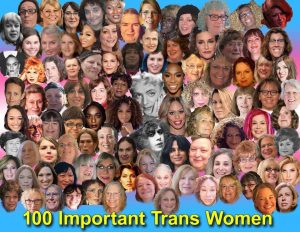 It is beyond safe to say that “at-home” life has changed radically for all of us as we cope with the challenges of the day-to-day in the midst of a global pandemic. In keeping with the theme of my recent posts regarding the transgender community and COVID-19, this piece does a wonderful job of bringing into focus the specific and unique challenges faced by transgender and non-binary youth living with the reality of stay-at-home orders…read article
It is beyond safe to say that “at-home” life has changed radically for all of us as we cope with the challenges of the day-to-day in the midst of a global pandemic. In keeping with the theme of my recent posts regarding the transgender community and COVID-19, this piece does a wonderful job of bringing into focus the specific and unique challenges faced by transgender and non-binary youth living with the reality of stay-at-home orders…read article
 And this is my biggest concern as we wait until June (!!!) for SCOTUS to rule. I have concerns that the ACLU’s argument that Aimee Stephens is an “insufficiently masculine” man who was fired for not adhering to male stereotypes is fraught with risk. Risk in further confusing judges that already do not quite get the gender identity argument at the root of what being trans is. Conversely, it does move the narrative away from gender identity – something that, arguably, a person cannot “see” when they meet a trans person for the first time – to the much more “visual” dimension of gender expression. Rather than looking at these dimensions of gender separately, the much more compelling – and complete – view is to present them together in explaining what the true essence of being transgender is.
And this is my biggest concern as we wait until June (!!!) for SCOTUS to rule. I have concerns that the ACLU’s argument that Aimee Stephens is an “insufficiently masculine” man who was fired for not adhering to male stereotypes is fraught with risk. Risk in further confusing judges that already do not quite get the gender identity argument at the root of what being trans is. Conversely, it does move the narrative away from gender identity – something that, arguably, a person cannot “see” when they meet a trans person for the first time – to the much more “visual” dimension of gender expression. Rather than looking at these dimensions of gender separately, the much more compelling – and complete – view is to present them together in explaining what the true essence of being transgender is.
 Supremely honored that my friend and fellow activist, Monica Helms, who is the creator of the transgender flag, included me on this list with such awesome trans women, most of whom I can count among my friends. If you click on the image you’ll find me right above the word “Trans”!
Supremely honored that my friend and fellow activist, Monica Helms, who is the creator of the transgender flag, included me on this list with such awesome trans women, most of whom I can count among my friends. If you click on the image you’ll find me right above the word “Trans”!
So, the HRC’s Corporate Equality Index for 2016 (CEI) has been out for a few months now and there are a number of companies that are newly minted “100’s” – in addition to the incumbent companies that have occupied the “perfect CEI score” space for a number of years now. In fact, according to my friends at the HRC’s Workplace Equality Program, the 2016 report contains the largest number of companies – 417 – that have garnered that coveted 100 score since its inception in 2002, and with it the right to promote themselves as “the best places to work for LGBT equality.” What’s more, a total of 511 “less-than-100” companies surveyed for the 2016 CEI now offer trans-inclusive healthcare – from a grand total of zero back in 2002. I suppose that means that there are 94 companies that still have work to do on one or more of the other CEI criteria, but I digress.
Regardless of the measurement, progress on transgender workplace inclusion has been clearly and definitively made and that is something we all can be very proud of. However, just because we’ve reached this new plateau doesn’t mean the work is finished. Hardly.
Flip the CEI over on its axis and you’ll see what I’m talking about. All you need do is look at the total number of companies that are a part of the survey – 851 – and do the math. Depending on which of the aforementioned numbers you choose, that means either 40% or 51% of companies on the survey still have unfinished business when it comes to creating fully inclusive workplaces for their transgender and gender non-conforming (GNC) employees and recruits – and by any measure, that’s still too many.
It is important to emphasize that this only pertains to the policy portion of the conversation. Arguably, the workplace inclusion narrative on transgender and GNC individuals has focused almost exclusively in this area. While that, of course, is beyond essential for creating the foundation for a safe and welcoming workplace, it is by no means a panacea.
Allow me to draw a personal parallel. When I transitioned a number of years ago, many of my colleagues and friends (both straight and LGBTQ) said that once my gender reassignment surgery (a choice, by the way, that was consistent with my own journey, and not meant to represent the entirety of the trans population) had been completed, my journey to my true self was also. The reality was that it was only just beginning, as I set out into the world living into my true self each and every day – and it continues to this day.
It’s much the same for trans and GNC workplace equality. Just because the policy work has been completed in a company does not mean the work is finished. In so many ways, it now signals a new phase of work that is equally, if not more, important: moving from policy to practice. As Chad Griffin, the HRC’s President, put it in his preamble to the latest CEI, “But we know that policies in and of themselves do not always translate into genuine inclusion of the transgender community. Critical cultural shifts need to take place to foster greater inclusion of the entire LGBT community.”
The reality of the matter is that for many companies, whether or not they have any “out” trans or GNC employees – that they know of – the next chapter of this workplace inclusion story will revolve around more basic things that will breathe life into their foundational policies. I have found, that for many of the companies I have worked with, more practical guidance is needed so that HR and D&I professionals can become more comfortable working with a transgender-identified person – for perhaps the first time in their life.
What type of practical guidance am I referring to? It has been my experience that this guidance falls into what I call the “Three C’s” of trans/GNC workplace inclusion:
Communication & Language
Cultural Acuity
Continued Education
Communication & Language
Communication can often be seen as the most basic of workplace skills, but it can often be the most overlooked. When viewed through the lens of trans/GNC workplace inclusion it is even more important. Communicating sincerely with authentic intent, along with non-verbal cues that send the message that you really do care is something that you might view as quite rudimentary, but to the trans/GNC employee – be they established or a new hire – it means everything, because for many, respectful conversation is seen as quite affirming of who they have always known themselves to be.
In this space I have previously discussed the importance of “getting the language right,“ because for many managers, doing the right thing involves not wanting to embarrass themselves or insult their trans/GNC colleagues by using incorrect or inappropriate words – like pronouns, for example. To be sure, that can be rather daunting for the uninitiated, but here’s the thing: when in doubt about what to say – just ask. What’s more, there are plenty of wonderful resources available to guide you in these conversations. For your reference, I have listed these at the conclusion of this article.
Cultural Acuity
When it comes to your company’s culture I have always felt that any workplace inclusion effort does not occur in a vacuum. Your strategy and tactics are always developed and executed against the backdrop of your company’s culture – and only you know what that is, for it can vary widely from enterprise to enterprise. But to be successful in bringing trans/GNC workplace inclusion policy into common practice it will require you to become a student – if you aren’t already – of your particular company’s culture. Only the culturally savvy individual – regardless of whether you are an HR or D& I professional, employee resource group leader or manager of a trans/GNC employee – will know how to navigate this culture to successfully build alliances with effective executive sponsors and business unit leaders who can further the cause of trans/GNC workplace inclusion.
The concern that I have is that despite our best efforts, we still are combatting bias – both conscious and unconscious – towards trans/GNC employees in workplaces across Corporate America. It is precisely this bias, regardless of your CEI score and adopted policies, that can inhibit trans and GNC employees from participating fully in ALL of the opportunities available to them within the enterprise: such as leadership and career development initiatives and opportunities for movement across business units and work teams.
Continued Education
In the end, diligence, persistency and continued education will carry the day as you embark on the objective of imbuing your organization with the special type of compassion that is required to ensure that your workplace practices the tenets of trans/GNC inclusion that your policies outline. Make no mistake about it, regardless of ever-increasing levels of visibility for the transgender community in popular culture, the need for education is great. It is precisely this element that can serve to eliminate fear and ultimately sow the seeds of acceptance – and inclusion – for transgender and gender non-conforming individuals both inside and outside of the workplace.
This story was originally featured in the February 22, 2016 edition of Diversity Best Practices’ Diversity in the News.
As she did last year, Stephanie will be returning to speak at the 2016 edition of the Forum on Workplace Inclusion sponsored the University of St. Thomas Opus College of Business and being held at the Minneapolis Convention Center in Minneapolis, Minnesota, March 29 – 31.
On Wednesday, March 30 from 1:30 pm – 3:00 pm she will present a workshop entitled, “So What Do We Do NOW? Evolving the Transgender Workplace Inclusion Narrative from Policy to Practice.”
The session overview outlines what will surely be an interactive and enlightening workshop for all who attend:
The current narrative with regard to the workplace issues of transgender and gender non-conforming individuals has tended to focus on the events and preparations leading up to the time of transition itself. This lively and engaging session evolves the conversation beyond this stage and covers an area that up to now has not been discussed—the post-transition (and beyond) story.
A major international voice in the workplace equality movement for transgender and gender non-conforming individuals, Stephanie throws open the shutters of this darkened room and casts a bright light on the pertinent issues that D& I and human resource professionals need to know to successfully transform their workplaces into a truly welcoming environment for ALL of their employees. Participants will learn key actionable takeaways that will “bring to life” their transgender-inclusive workplace policies and procedures – and leave better prepared to be an advocate / ally.
To learn more about this wonderful conference, you can access a downloadable PDF summary HERE.
You can also access the 2016 Forum website HERE.
Hope to see you there!
- « Previous
- 1
- …
- 9
- 10
- 11
